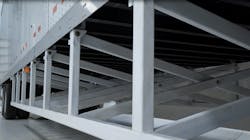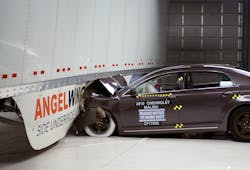The National Highway Traffic Safety Administration asked for input on the pros and cons of a side underride guard (SUG) regulation for commercial trailers, and got it: Some 2,000 individuals and organizations responded to a series of agency questions during the extended comment period that closed July 20.
Key stakeholders broadly agree on one thing: NHTSA’s cost-benefit analysis is flawed. For commercial transportation groups, the agency has underestimated costs and overstated benefits; numerous highway safety advocates looked at the analysis and drew the opposite conclusion.
In the April 21 advanced notice of proposed rulemaking (ANPRM), the agency outlines the result of a study, mandated by the Infrastructure Investment and Jobs Act, on side underride guards. NHTSA completed the study in 2022 and estimated that about 17 lives would be saved and 69 serious injuries would be prevented annually if the guards were mandatory.
See also: Trailer underride guards vs. aero skirts: Potential to save lives
NHTSA calculates the total cost of installing underride guards on a trailer, including hardware costs and paying for an average of three hours of installation labor, to be $2,990 in 2020 dollars, which adjusted for inflation is almost $3,500 as of March 2023. At 260,000 new trailers sold annually, the total annual cost for equipping all applicable new trailers with side underride guards would be about $832 million in 2023. Estimates are based on the AngelWing guards manufactured by Airflow Deflector.
Equipping a new trailer with side underride guards is estimated to generate about $490 to $640 in lifetime safety benefits.
TTMA challenges feasibility
The Truck Trailer Manufacturers Association (TTMA), which represents domestic and international manufacturers responsible for approximately 90% of the heavy-duty trailers manufactured for use in the U.S., consistently has stated that it would support the implementation of side underride guards “if they ever become both justified and technologically feasible.”
However, TTMA suggests the assumed effectiveness of the side guards “seems unrealistically high,” and calls for additional data on crashes, including seatbelt use and crash angles, noting “significant gaps” in the areas protected by underride guards. Additionally, TTMA has seen no data to back any significant benefit that SUGs might have for impacts over 40mph.
TTMA also restates its previous analysis that the extra weight of SUGs and reduced trailer payload would result in an additional 184 million truck miles per year, meaning 2.7 additional fatalities per year for every additional 250 lbs. of weight.
“The net effect of this is to reduce DOT calculated benefits by just about half of what is presented,” TTMA asserts.
See also: NHTSA updates rear impact guard standards
And DOT might not be aware of “the degree of customization” the trailer industry employs to meet customer needs. “Our members are of general agreement that there is no ‘one-size-fits-all’ approach that will work throughout the industry,” TTMA states. And this means the engineering and manufacturing costs will be higher than NHTSA’s estimates.
“As far as TTMA is aware, commercially available SUG designs only exist for box-type trailer designs and no device has yet been developed for the multitude of other designs,” including intermodal chassis, tankers, and agricultural trailers that are designed to travel off road.
Similarly, TTMA members have expressed concerns about SUGs and ground clearance, and the risks posed by damaged guards. "The magnitude of this risk to the motoring public will be hard to quantify, but TTMA believes it could easily exceed any possible benefit,” TTMA writes.
“TTMA believes that the safety benefit of SUGs is overstated, and there are detriments to safety that are not yet taken fully into account,” the comment concludes. “We generally support the recommendations in the March 2019 GAO report calling for improved data collection, inspection and research.”
IM chassis ‘impossible’
Indeed, comments filed by organizations involved in intermodal transportation—such as the Association of American Railroads and the Intermodal Association of North America—detail the “significant adverse impacts” of new SUG regulations.
The comment emphasizes that Congress included language that specifically requires the DOT to consider the “unique structural and operational aspects” of intermodal chassis when evaluating a side underride guard requirement—a requirement that “has not been completed and must be duly considered,” the comment states.
“The application of a side underride guard requirement to intermodal chassis would pose significant physical and operational issues at every major port and rail terminal in the United States,” the groups insist, pointing to various “impossibilities” such as chassis stacking and the absence of crossmembers on chassis for needed SUG support.
The Owner-Operator Independent Drivers Association echoes many of the opinions expressed by the trailer manufacturers and intermodal organizations.
“Nobody cares about road safety more than truck drivers and every single truck driver wants to operate in a safe environment to return home just like drivers in passenger vehicles. NHTSA has considered numerous options involving side underride guards, but has consistently concluded a federal mandate would be impractical and costly, thus outweighing any safety benefits,” OOIDA President and CEO Todd Spencer writes. “Any potential mandate also fails to recognize numerous other issues limiting the practicality of side underride guards.
“Any move by the agency to advance such a measure is premature and shortsighted.”
The American Truck Dealers arm of the National Automobile Dealers Association also calls for more research.
“ATD acknowledges that side underride guards may reduce the likelihood of serious injury or death resulting from crashes with CMV trailers and semitrailers in certain circumstances and supports NHTSA’s efforts to obtain additional information through the ANPRM to study CMV side underride crashes,” the organization writes. “However, given the incomplete nature of the available research and data, as well as the exorbitant costs and detrimental impacts to CMV operators and carriers, ATD does not support a side underride guard mandate and urges NHTSA not to proceed with a formal rulemaking.”
DOT inaction 'disgusting'
The filing by the Truck Safety Coalition (TSC), Citizens for Reliable and Safe Highways (CRASH), Parents Against Tired Truckers (PATT) takes the Department of Transportation to task for failing to act on side underride regulations since promising to do so in 1969.
“On behalf of all truck crash victims and survivors, TSC is disgusted by DOT’s inaction and rebukes, in the strongest possible terms, DOT’s over half-century of inaction and inappropriate deference to the bottom-line interests of industry lobbyists,” the comment reads.
Specifically, DOT made no effort to collect the requisite data to understand the scope and scale of underride fatalities and injuries “until quite recently,” despite being admonished by the Insurance Institute for Highway Safety to do just that in 1992, TSC writes, noting that the National Transportation Safety Board (NTSB) also encouraged NHTSA to improve its trailer underride data collection in 2014.
“Not only has NHTSA inexplicably taken no action to improve its underride data collection or side underride guard impact testing until the past year, recent reporting by Frontline PBS and ProPublica reveal highly inappropriate influence ceded to the trucking industry, specifically the American Trucking Association [sic], to minimize the need and potential lifesaving efficacy of side underride guards,” TSC states.
See also: Safety groups question merits of federal driver apprenticeship program
While supporting NHTSA’s recent efforts to move forward, TSC argues that underride-related crashes are severely undercounted in federal data, and that previous cost-benefit analysis underestimated the economic value of lives saved and failed to account for aerodynamic improvements and fuel-saving benefits of side underride systems.
“These self-inflicted flaws prohibit NHTSA’s ability to propose a Side Underride Guard Rule that places the best interest of the public first and adequately considers the impact of regulatory inaction,” the groups conclude.
Similarly, the Institute for Safer Trucking (IST) and Road Safe America (RSA) express “disappointment” in NHTSA’s cost-benefit analysis.
IST’s 2022 Safer Trucking Report looked at the differences in reported underride fatalities between five states with an underride field on their police accident report (Pa., N.C., Ill., Ky, Iowa) and five states without such a field (Texas, Calif., Fla., Ga., Ohio). From 2011 to 2020, states with an underride field reported 2.7 times as many truck underride deaths, an “alarming” difference, according to the filing.
NHTSA should also include vulnerable road users (VRUs) such as bicyclists and pedestrians in analyses pertaining to the benefits of side underride guards, the groups contend.
The vast majority of comments from individuals favor side underride protection for the protection of VRUs, with most of these using similar language in support of the League of American Bicyclists.
“Each year, approximately 500 vulnerable road users lose their lives in collisions with large trucks. A study conducted by the NTSB highlights that a majority of bicyclist and pedestrian fatalities involving large trucks occur in side impact crashes,” as many comments state in the form-letter submissions. “Furthermore, the US DOT Volpe Center's research reveals that side guards can reduce fatalities from bicycle-large truck crashes by 55-75 percent and pedestrian-large truck crashes by 20-29 percent.”
About the Author
Kevin Jones
Editor
Kevin has served as editor-in-chief of Trailer/Body Builders magazine since 2017—just the third editor in the magazine’s 60 years. He is also editorial director for Endeavor Business Media’s Commercial Vehicle group, which includes FleetOwner, Bulk Transporter, Refrigerated Transporter, American Trucker, and Fleet Maintenance magazines and websites.
Working from Beaufort, S.C., Kevin has covered trucking and manufacturing for nearly 20 years. His writing and commentary about the trucking industry and, previously, business and government, has been recognized with numerous state, regional, and national journalism awards.


